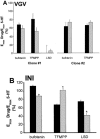RNA-editing of the 5-HT(2C) receptor alters agonist-receptor-effector coupling specificity
- PMID: 11564657
- PMCID: PMC1572953
- DOI: 10.1038/sj.bjp.0704255
RNA-editing of the 5-HT(2C) receptor alters agonist-receptor-effector coupling specificity
Abstract
1. The serotonin(2C) (5-HT(2C)) receptor couples to both phospholipase C (PLC)-inositol phosphate (IP) and phospholipase A(2) (PLA(2))-arachidonic acid (AA) signalling cascades. Agonists can differentially activate these effectors (i.e. agonist-directed trafficking of receptor stimulus) perhaps due to agonist-specific receptor conformations which differentially couple to/activate transducer molecules (e.g. G proteins). Since editing of RNA transcripts of the human 5-HT(2C) receptor leads to substitution of amino acids at positions 156, 158 and 160 of the putative second intracellular loop, a region important for G protein coupling, we examined the capacity of agonists to activate both the PLC-IP and PLA(2)-AA pathways in CHO cells stably expressing two major, fully RNA-edited isoforms (5-HT(2C-VSV), 5-HT(2C-VGV)) of the h5-HT(2C) receptor. 2. 5-HT increased AA release and IP accumulation in both 5-HT(2C-VSV) and 5-HT(2C-VGV) expressing cells. As expected, the potency of 5-HT for both RNA-edited isoforms for both responses was 10 fold lower relative to that of the non-edited receptor (5-HT(2C-INI)) when receptors were expressed at similar levels. 3. Consistent with our previous report, the efficacy order of two 5-HT receptor agonists (TFMPP and bufotenin) was reversed for AA release and IP accumulation at the non-edited receptor thus demonstrating agonist trafficking of receptor stimulus. However, with the RNA-edited receptor isoforms there was no difference in the relative efficacies of TFMPP or bufotenin for AA release and IP accumulation suggesting that the capacity for 5-HT(2C) agonists to traffic receptor stimulus is lost as a result of RNA editing. 4. These results suggest an important role for the second intracellular loop in transmitting agonist-specific information to signalling molecules.
Figures



Similar articles
-
Effector pathway-dependent relative efficacy at serotonin type 2A and 2C receptors: evidence for agonist-directed trafficking of receptor stimulus.Mol Pharmacol. 1998 Jul;54(1):94-104. Mol Pharmacol. 1998. PMID: 9658194
-
Serotonin 5-HT2C receptor RNA editing alters receptor basal activity: implications for serotonergic signal transduction.J Neurochem. 1999 Oct;73(4):1711-7. doi: 10.1046/j.1471-4159.1999.731711.x. J Neurochem. 1999. PMID: 10501219
-
RNA editing of the human serotonin 5-HT2C receptor. alterations in suicide and implications for serotonergic pharmacotherapy.Neuropsychopharmacology. 2001 May;24(5):478-91. doi: 10.1016/S0893-133X(00)00223-2. Neuropsychopharmacology. 2001. PMID: 11282248
-
Pleiotropic behavior of 5-HT2A and 5-HT2C receptor agonists.Ann N Y Acad Sci. 1998 Dec 15;861:104-10. doi: 10.1111/j.1749-6632.1998.tb10180.x. Ann N Y Acad Sci. 1998. PMID: 9928246 Review.
-
Serotonin 2C receptors: suicide, serotonin, and runaway RNA editing.Neuroscientist. 2003 Aug;9(4):237-42. doi: 10.1177/1073858403253669. Neuroscientist. 2003. PMID: 12934707 Review.
Cited by
-
Assessing serotonin receptor mRNA editing frequency by a novel ultra high-throughput sequencing method.Nucleic Acids Res. 2010 Jun;38(10):e118. doi: 10.1093/nar/gkq107. Epub 2010 Feb 25. Nucleic Acids Res. 2010. PMID: 20185571 Free PMC article.
-
Pharmacological characterization of mitogen-activated protein kinase activation by recombinant human 5-HT2C, 5-HT2A, and 5-HT2B receptors.Naunyn Schmiedebergs Arch Pharmacol. 2009 May;379(5):461-71. doi: 10.1007/s00210-008-0378-4. Epub 2008 Dec 5. Naunyn Schmiedebergs Arch Pharmacol. 2009. PMID: 19057895
-
An innovative real-time PCR method to measure changes in RNA editing of the serotonin 2C receptor (5-HT(2C)R) in brain.J Neurosci Methods. 2009 May 15;179(2):247-57. doi: 10.1016/j.jneumeth.2009.01.027. Epub 2009 Feb 7. J Neurosci Methods. 2009. PMID: 19428534 Free PMC article.
-
Mice with altered serotonin 2C receptor RNA editing display characteristics of Prader-Willi syndrome.Neurobiol Dis. 2010 Aug;39(2):169-80. doi: 10.1016/j.nbd.2010.04.004. Epub 2010 Apr 13. Neurobiol Dis. 2010. PMID: 20394819 Free PMC article.
-
Dynamic 5-HT2C receptor editing in a mouse model of obesity.PLoS One. 2012;7(3):e32266. doi: 10.1371/journal.pone.0032266. Epub 2012 Mar 20. PLoS One. 2012. PMID: 22448217 Free PMC article.
References
-
- BACKSTROM J.R., CHANG M.S., CHU H., NISWENDER C.M., SANDERS-BUSH E. Agonist-directed signaling of serotonin 5-HT2C receptors: differences between serotonin and lysergic acid diethylamide (LSD) Neuropsychopharmacology. 1999;21:77S–81S. - PubMed
-
- BERG K.A., CLARKE W.P., SAILSTAD C., SALTZMAN A., MAAYANI S. Signal transduction differences between 5-hydroxytryptamine type 2A and type 2C receptor systems. Mol. Pharmacol. 1994;46:477–484. - PubMed
-
- BERG K.A., MAAYANI S., CLARKE W.P. 5-hydroxytryptamine 2C receptor activation inhibits 5-hydroxytryptamine 1B-like receptor function via arachidonic acid metabolism. Mol. Pharmacol. 1996;50:1017–1023. - PubMed
-
- BERG K.A., MAAYANI S., GOLDFARB J., SCARAMELLINI C., LEFF P., CLARKE W.P. Effector pathway-dependent relative efficacy at serotonin type 2A and 2C receptors: evidence for agonist-directed trafficking of receptor stimulus. Mol. Pharmacol. 1998;54:94–104. - PubMed
-
- BERG K.A., STOUT B.D., CROPPER J.D., MAAYANI S., CLARKE W.P. Novel actions of inverse agonists on 5-HT2C receptor systems. Mol. Pharmacol. 1999;55:863–872. - PubMed
Publication types
MeSH terms
Substances
Grants and funding
LinkOut - more resources
Full Text Sources
Medical
Molecular Biology Databases
Research Materials

